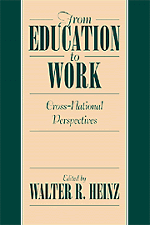Book contents
- Frontmatter
- Contents
- Contributing Authors
- Preface
- Introduction: Transitions to Employment in a Cross-National Perspective
- Part I Social Origin, Gender, and Transition Patterns
- Part II Education and Labour Markets: Work Experiences, Skills, and Credentials
- 5 Adolescent Part-Time Work and Postsecondary Transition Pathways in the United States
- 6 Multiple Life-Sphere Participation by Young Adults
- 7 The Subbaccalaureate Labor Market in the United States: Challenges for the School-to-Work Transition
- 8 Creating New Pathways to Adulthood by Adapting German Apprenticeship in the United States
- 9 Job-Entry Patterns in a Life-Course Perspective
- Part III Changes in the Social Context of Transitions
- References
- Index
8 - Creating New Pathways to Adulthood by Adapting German Apprenticeship in the United States
Published online by Cambridge University Press: 30 September 2009
- Frontmatter
- Contents
- Contributing Authors
- Preface
- Introduction: Transitions to Employment in a Cross-National Perspective
- Part I Social Origin, Gender, and Transition Patterns
- Part II Education and Labour Markets: Work Experiences, Skills, and Credentials
- 5 Adolescent Part-Time Work and Postsecondary Transition Pathways in the United States
- 6 Multiple Life-Sphere Participation by Young Adults
- 7 The Subbaccalaureate Labor Market in the United States: Challenges for the School-to-Work Transition
- 8 Creating New Pathways to Adulthood by Adapting German Apprenticeship in the United States
- 9 Job-Entry Patterns in a Life-Course Perspective
- Part III Changes in the Social Context of Transitions
- References
- Index
Summary
The United States was the first country to create a universal system of free public education. Promoted by its advocates as a bastion of democracy, it was also a source of national prosperity. In addition to being able to read newspapers and the Bible, literate farmers and workers were more productive because of their capacity to communicate in writing and to do simple math. The shift in the locus of economic activity from agriculture to manufacturing was accompanied by progressively higher educational levels in the general population. Until World War II, however, graduation from high school remained a signal distinction, one attained primarily by young men bound for colleges and universities, where they would study for the professions, and for young women and men who would teach school and work in the offices that were employing a steadily increasing proportion of the population (Coleman, 1974; Cremin, 1977). By 1995, 86.9% of 25- to 29-year-olds had graduated from high school or obtained a high school general equivalency diploma, or GED (US Department of Education, 1996, p. 92).
The GI Bill after World War II opened higher education to a proportion of the population unmatched in previous history and unapproached by any other country for 2 decades.
- Type
- Chapter
- Information
- From Education to WorkCross National Perspectives, pp. 194 - 213Publisher: Cambridge University PressPrint publication year: 1999
- 18
- Cited by



